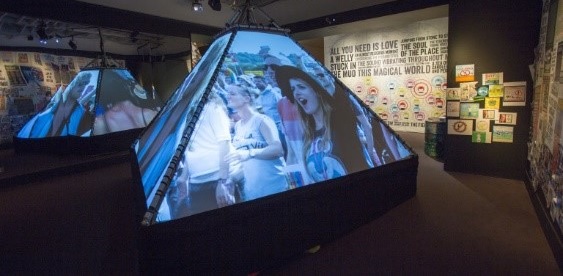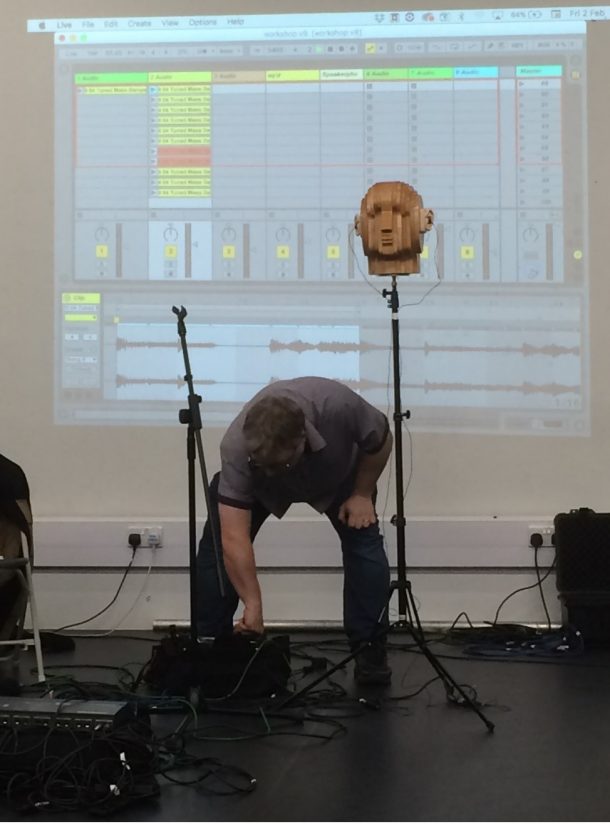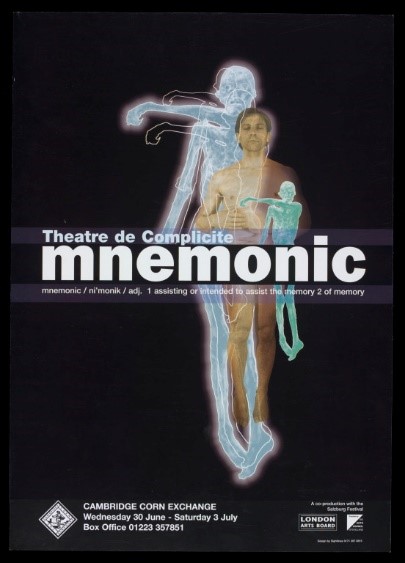Assistant Curator Harriet Reed shares her experience of a sound design workshop led by Complicité Theatre Company.
Sound design is often the invisible unsung hero of theatre – it is always present but never intrusive, subtly altering our emotions in relation to whatever else is happening onstage.
It is a subject that the Theatre and Performance Department has been exploring not only in relation to its use in contemporary theatre, but also its role in ‘immersive’ multimedia exhibitions – a genre which has been developing at the V&A over the past ten years.
Sound designer Gareth Fry has worked extensively with Complicité Theatre Company, including on ‘The Encounter’ which innovatively used binaural sound as a storytelling device to recreate the Amazon rainforest – and returns to the Barbican this April. He has also worked with the V&A on its major exhibition ‘David Bowie Is’ and the installation ‘Glastonbury: Land and Legend’ (September 2016 – February 2017).

On 1st – 2nd February 2018 I attended the workshop ‘The Story Through Sound Design led by Gareth Fry’, funded by the V&A Training and Development Fund, and received a crash course in this complex and intriguing process.
What do our ears pay attention to?
We first learnt some principles about sound design, including how our brain and ears interact. Gareth used the metaphor of a junk-mail filter, which our brain uses to filter out what sounds are worth hearing, including:
- New sounds (a car alarm)
- When a sound that has been constant suddenly stops (the hum of a fridge turning off)
- Sounds of motion (someone running towards us)
- Sounds which relate to our mood (if we are tense, we are more alert to footsteps)
Sound design manipulates these hearing principles in many different ways through changes in volume, frequency, direction, localisation and proximity. This ‘sleight of hand’ type of work which doesn’t pique audience awareness is similar to The Moonwalking Bear Awareness Test.
Sound design and music
Gareth then moved on to the use of music in sound design, where we discussed the different roles or cues it occupies in theatre, including:
- Transitional (new scene)
- Emotional/catharsis (heighten or break a narrative climax)
- Contextual (a period or location)
In terms of exhibitions, music not only often features as an ‘object’ itself (for example in music exhibitions such as ‘David Bowie Is’ and ‘Pink Floyd: Their Mortal Remains’) but can also be used to choreograph the visitor, holding them in front of certain objects, pacing their movement between sections, and signalling thematic changes.
However, Gareth made the important point that the audience mustn’t feel like they are being manipulated (unlike certain theatrical genres such as musicals, where an audience member goes into ‘Les Miserables’ expecting to and wanting to be emotionally manipulated).
Binaural sound and ‘The Encounter’
Using the software QLab and Ableton Live, as well as a binaural head named ‘John’, Gareth demonstrated how ‘The Encounter’ used sound design to bring its story of the photographer Loren McIntyre and the Amazon rainforest to life.

Binaural heads have a mic placed in each ear which records sound as a human would hear it. While a head on a stick looks slightly comical, it is important to have a ‘mass’ between each ear for a binaural mic as this stops the sound from getting in both ears (unless you are standing right in front of it).
To demonstrate this, while we were wearing headphones Gareth spoke into John’s left ear and we would hear it in our left ear. It creates an intimacy between the performer and the audience which feels personal and immersive – almost like there is a voice in your head.
For ‘The Encounter’, in which Simon McBurney describes a journey and inhabits different characters, he uses the binaural head to make his voice a mask. This is a transparent process and the audience can see this happening onstage – sound design in this case is the visible component of theatre.
While Simon performs, Gareth simultaneously manipulates his voice (through reverb, direction, looping) to transform him into a different person in a different location.
The sound design for the production is performative itself, requiring two operators behind the scenes and one on stage to manage the many cues which are off-script. Complicité often work in this off-the-cuff way. On the first night performance of their play Mnemonic, the sound design for the ending was still unfinished and was completely improvised live!

The future of sound design?
Sound design is becoming increasingly performative and complex. Film and theatre continue to influence each other in this regard, generally becoming more ambitious with numbers of scenes, locations and characters – all of which require differentiated soundscapes.
While binaural sound was already commonly used before ‘The Encounter’, it is also being incorporated into new AR, VR and 360 sound techniques which are advancing sound design in theatre and in museums.
If you want to find out more, visit Gareth’s website: http://www.garethfry.co.uk/
More information about ‘The Encounter’ and Complicité’s work can be found here: http://www.complicite.org/index.php
To explore the V&A Collections relating to Complicité visit Search the Collections.


